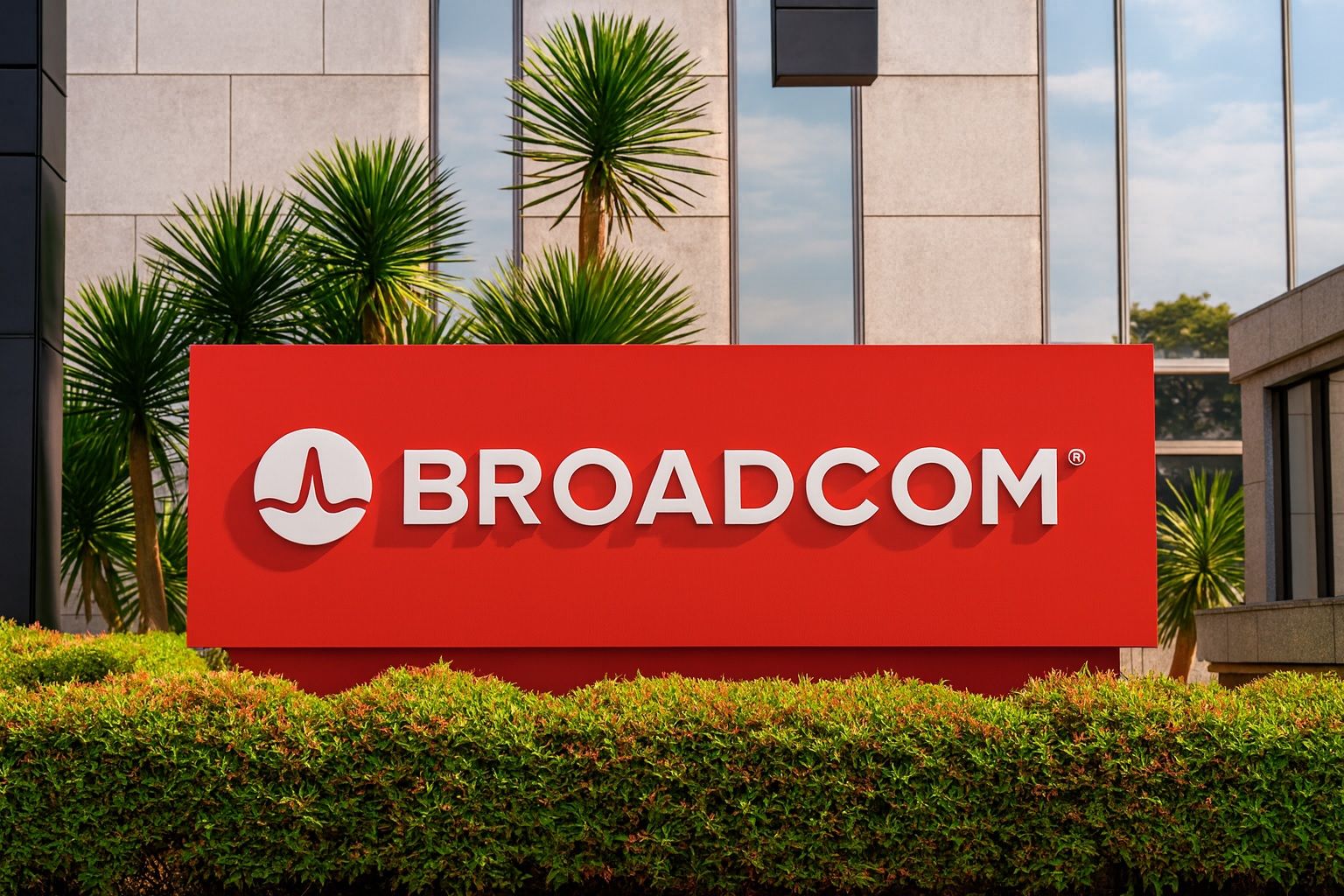- Stock Price (Oct 24, 2025): AVGO closed around $356.70, up about 3.6% on the day [1].
- Q3 Earnings: Broadcom reported $15.95 billion in Q3 FY2025 revenue (+22% YoY) and record free cash flow of ~$7.0 billion [2] [3].
- Big AI Deal: On Oct. 13, Broadcom announced a partnership with OpenAI to co-develop 10GW of custom AI chips (worth ~$10 billion) [4], which sent the stock up ~10% on the news.
- Guidance Raised: Management now expects Q4 revenue ~$17.4 billion (well above street forecasts) and forecasts AI chip sales of $6.2 billion next quarter [5] [6].
- Analyst Sentiment: About 90% of analysts rate AVGO a “Buy” [7], with consensus 12-month targets in the mid-$300s. Several firms have aggressive targets (e.g. Mizuho’s $410 and some banks modeling $450–460 levels, implying ~30% upside [8] [9]).
- Chip Sector Rally: The semiconductor index recently hit record highs [10]. Peers Nvidia and AMD have also surged on AI momentum: Nvidia still dominates AI GPUs (~80–90% market share [11]), while AMD hit an all-time high on Oct. 24, 2025 (up 90% YTD) amid its own OpenAI GPU deal [12] [13].
- Risks: Broadcom’s valuation is extremely high (roughly 50× forward P/E [14]). Macro or regulatory shocks (e.g. U.S.–China trade issues or an EU antitrust complaint over Broadcom’s VMware licensing) have caused volatility [15] [16].
Broadcom’s stock has soared in recent days as the chipmaker emerges as a central player in the booming AI industry. On Friday, Oct. 24, the shares were trading in the mid-$350s – about double their level a year earlier – and were up around 3–4% on the day [17]. The recent jump follows a series of bullish developments for AVGO. Notably, Broadcom announced an $10 billion AI chip deal with OpenAI on Oct. 13. Under this partnership, Broadcom will co-design 10 gigawatts of custom AI accelerator chips for OpenAI over the next few years [18]. Investors cheered the news: the stock spiked roughly 10% on the day of the announcement [19]. OpenAI’s CEO Sam Altman praised the tie-up as “a critical step in building the infrastructure needed to unlock AI’s potential” [20], highlighting the deal’s importance to AI data-center expansion. Broadcom also introduced new products for AI (like its “Thor Ultra” networking chip) in mid-October, further boosting confidence in its AI roadmap [21].
The earnings picture has been just as bright. In early September, Broadcom reported blockbuster Q3 results (ended Aug. 3, 2025). Revenue jumped 22% year-over-year to $15.95 billion, beating Wall Street estimates [22]. Remarkably, Broadcom turned that revenue into about $7.0 billion of free cash flow (roughly 44% of sales) [23] – a record margin reflecting strong demand for its chips and networking gear. Management highlighted that new AI accelerator orders (along with high-speed networking chips and VMware software sales) drove this “record third quarter revenue” [24]. On the conference call, CEO Hock Tan said AI was the big driver, noting that AI semiconductor revenue grew 63% year-over-year to $5.2 billion in Q3 and forecasting it will rise to about $6.2 billion in Q4 [25] [26]. Broadcom raised its Q4 revenue outlook to roughly $17.4 billion [27] – comfortably above the consensus of ~$17.0 billion – implying about 24% annual growth. In short, Broadcom delivered a classic “beat-and-raise” quarter, underscoring its run-rate to a nearly $20 billion annual AI revenue run-rate [28] [29]. (For context, Broadcom has now posted double-digit growth for over 10 consecutive quarters, largely on the back of AI demand [30].)
Wall Street has rewarded Broadcom’s results. About 9 in 10 analysts now rate AVGO a Buy or Outperform [31]. Consensus 12-month price targets hover in the mid-$300s [32], but many firms are much more optimistic. For example, Mizuho Securities recently dubbed Broadcom the “king of AI custom chips” and raised its price target to $410 [33]. A TS2.tech report notes that banks like KeyBanc and Barclays are modeling targets around $450–460 (roughly 30%+ upside) [34]. In one analysis, TipRanks observes that Broadcom’s AI-driven growth “justifies” even rich valuations: an analyst there forecasts about 20–30% upside over the next year, given the company’s AI momentum [35]. Consumers and tech investors alike have taken note: Broadcom has now joined the ranks of the so-called Magnificent Seven megacaps (alongside Nvidia, Apple, etc.), reaching a market value near $1.6 trillion [36].
Industry trends and peers: Broadcom’s surge comes amid a broader semiconductor boom. The Philadelphia Semiconductor Index (SOX) recently hit record highs [37] as tech companies report strong earnings and chip demand. Nvidia (NASDAQ: NVDA) remains the dominant force in AI graphics chips (controlling roughly 80–90% of data-center GPU capacity [38]), but Broadcom has steered clear of a head-on GPU battle. Instead, Broadcom focuses on custom ASIC accelerators and networking switches for hyperscale cloud providers – a strategy sometimes called “coopetition.” In effect, Broadcom’s chips and Ethernet products complement Nvidia’s GPUs by helping to scale out data centers [39]. As eMarketer analyst Jacob Bourne puts it, Broadcom’s “custom offerings for cloud giants are well-positioned as Big Tech races to push model training and inference forward” [40]. In other words, Broadcom has carved out a niche as hyperscalers (Google, Meta, etc.) and AI labs (like OpenAI) demand specialized chips beyond off-the-shelf GPUs.
Rivals are also in motion. AMD (NASDAQ: AMD) has had a stellar year; its stock hit an all-time high near $243 on Oct. 24, 2025 (up ~90% year-to-date) [41]. Much of that rally came from AMD’s own AI deals: on Oct. 6, AMD announced a multi-year partnership to supply OpenAI with GPUs (about 6 GW capacity) and a separate deal with Oracle Cloud. That news sent AMD’s shares up over 34% in a single day [42]. Broadcom’s Hock Tan even mentioned that other large cloud customers have placed big ASIC orders, suggesting Broadcom has multiple potential deals in the works (beyond OpenAI) [43]. Intel also saw its stock jump after better-than-expected results; Intel CEO Pat Gelsinger highlighted a new ASIC/chip division aimed at competing with Broadcom’s custom chip business [44]. In summary, chipmakers of all kinds are riding the AI wave, and Broadcom’s recent wins (especially the OpenAI deal) are widely seen as validating its role. As one industry observer noted, AMD’s OpenAI contract helped “validate” AMD’s tech – similarly, Broadcom’s new contract is “a vote of confidence in its chips.” [45]
Outlook and risks: Looking ahead, much depends on execution and continued AI spending. Analysts generally expect Broadcom to keep benefiting from the AI supercycle – hence the bullish sentiment. However, the stock is already trading on very lofty expectations. Its forward earnings multiple is around 50×, far above typical chip valuations [46]. Some investors warn that any slowdown in cloud spending or stiff competition could be a shock. For example, Broadcom’s success hinges on a few very large customers; if one hyperscaler decides to develop in-house chips or cut orders, growth could suffer. Geopolitical and regulatory issues are also concerns. Broadcom briefly fell 5–6% on Oct. 10 when trade tensions spiked [47]. In Europe, a cloud providers’ group has filed an EU complaint alleging that Broadcom’s post-merger licensing of VMware (bought for $69B in 2023) is “unfair” [48], suggesting more scrutiny ahead. On the positive side, about 42% of Broadcom’s revenue now comes from its VMware software business, which provides steady cash flow and diversifies its mix [49].
Bottom line: Broadcom’s stock rally is rooted in real business momentum — notably its booming AI chip sales and the landmark OpenAI partnership. The company’s latest earnings and guidance reinforce that story, and analysts are broadly optimistic on AVGO’s next leg. Whether the stock can justify its rich valuation will depend on continued execution. For now, Broadcom stands at the center of the AI boom: one commentator cheerfully dubs it “the king of AI custom chips” [50], and many on Wall Street expect more gains in 2026 as AI data centers expand.
Sources: Recent Broadcom and sector developments are reported by financial news outlets and tech publications. Key data and quotes are drawn from market analytics sites (Investing.com [51], TipRanks [52]), tech news sites (TechStock²/ts2.tech [53] [54]), and reputable financial media (Reuters [55] [56], MarketBeat [57], etc.). All figures are as of Oct. 24, 2025.
References
1. www.investing.com, 2. ts2.tech, 3. ts2.tech, 4. ts2.tech, 5. ts2.tech, 6. ts2.tech, 7. ts2.tech, 8. ts2.tech, 9. ts2.tech, 10. ts2.tech, 11. ts2.tech, 12. tokenist.com, 13. ts2.tech, 14. ts2.tech, 15. ts2.tech, 16. ts2.tech, 17. www.investing.com, 18. ts2.tech, 19. ts2.tech, 20. ts2.tech, 21. ts2.tech, 22. ts2.tech, 23. ts2.tech, 24. ts2.tech, 25. ts2.tech, 26. ts2.tech, 27. ts2.tech, 28. ts2.tech, 29. ts2.tech, 30. ts2.tech, 31. ts2.tech, 32. ts2.tech, 33. ts2.tech, 34. ts2.tech, 35. www.tipranks.com, 36. ts2.tech, 37. ts2.tech, 38. ts2.tech, 39. ts2.tech, 40. ts2.tech, 41. tokenist.com, 42. www.reuters.com, 43. ts2.tech, 44. 247wallst.com, 45. ts2.tech, 46. ts2.tech, 47. ts2.tech, 48. ts2.tech, 49. ts2.tech, 50. ts2.tech, 51. www.investing.com, 52. www.tipranks.com, 53. ts2.tech, 54. ts2.tech, 55. ts2.tech, 56. www.reuters.com, 57. ts2.tech








